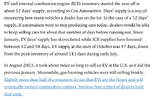- Joined
- 3 July 2009
- Posts
- 28,203
- Reactions
- 25,448
I don’t think you understand what I am saying, have another read of my last two posts.
I am asking you which of the range estimates you are talking about there are two.
1. “The rated range” eg what the brochure says the car will do, of course your actual experience will fluctuate wildly depending on what you are doing.
Or
2. You personal vehicles calculation that it makes for you that day (maybe your car doesn’t do this). When you plug in your destination into the GPS.
I will take a photo of what I mean today.
Basically number 2 is very accurate, number 1 is not.
I'm struggling to understand where you are confused.
Tesla accused of intentionally overestimating driving range, secretly dodging complaints – report
A special report claims Tesla created software which would deliberately overestimate the driving range of its vehicles.
Last edited:


